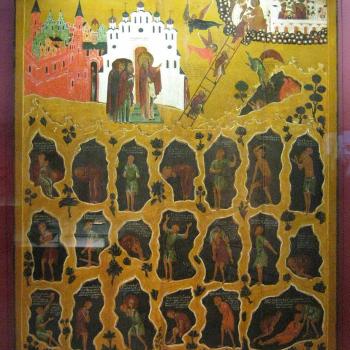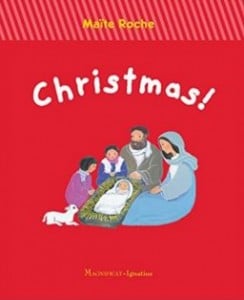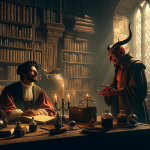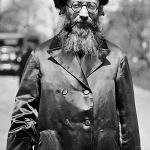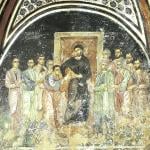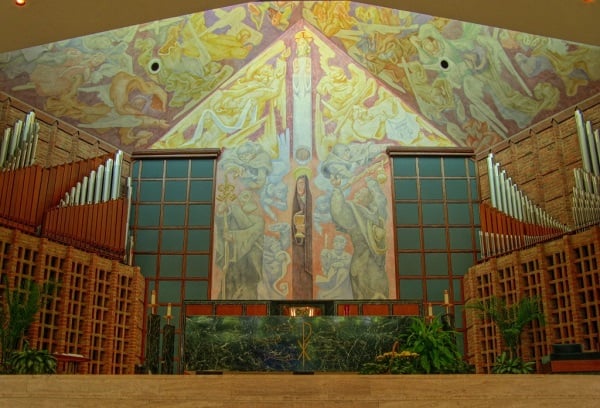 Long and black, sorrowing an eighth time at the Ascension of her Son, she’s nicknamed the “Pencil Madonna.” She’s the prominent figure in a striking mural behind the altar at Our Lady of Sorrows Parish in Farmington, Michigan. The mural also features a “Pencil Jesus” hovering just over His Mother’s head, ascending to heaven.
Long and black, sorrowing an eighth time at the Ascension of her Son, she’s nicknamed the “Pencil Madonna.” She’s the prominent figure in a striking mural behind the altar at Our Lady of Sorrows Parish in Farmington, Michigan. The mural also features a “Pencil Jesus” hovering just over His Mother’s head, ascending to heaven.
The contemporary fresco was painted in the summer of 1961 by French artist Jean Charlot. Born in Paris, France, then living and working in Mexico, Charlot applied to become a naturalized American in 1940. In the United States, he worked in Manhattan and in Colorado before accepting a professorship teaching art at the University of Hawaii at Manoa. His murals can be seen in San Francisco, Honolulu, Cleveland and other cities.
In designing the fresco, Charlot sought to produce a “liturgical catechesis” echoing the message conveyed in the church’s stained glass windows, which were designed and constructed by Gabriel Loire of the famed Loire Studios in Chartres, France. The three-quarters-inch thick “slab glass” windows depict Mary’s seven sorrows:
- The Prophecy of Simeon, “And thine own soul a sword shall pierce;”
- The flight into Egypt, which meant hardship and inconvenience;
- Christ is lost in Jerusalem at the age of 12;
- Christ leaves his home to do his Father’s business;
- The meeting of Christ and his Mother on the way to Calvary where she sees and feels his pain;
- Mary stands at the foot of the cross and watches Jesus die; and
- Christ is taken down from the Cross and Mary holds her dead son in her arms.
With the traditional seven sorrows already represented in the stained glass, Jean Charlot sought to show yet another of the great sorrows which Mary bore. He chose to depict an eighth “sorrow”—the Ascension of Jesus into heaven, when Mary was separated from her beloved Son.
Charlot himself explained the work:
“I looked for a sorrow of hers not included in the traditional series, and linked directly to Christ’s mysteries. The Ascension of Our Lord, glorious in nature, nevertheless represents a parting of Mother and Son, and thus, from Mary’s point of view, a Sorrow. This double nature of the Mystery, glorious and sorrowful, allows a striking visualization based on contrast. The white of Christ ascending is framed in yellows, suggesting the full light of heaven. The black of Mary is framed between the gray silhouettes of the departing Apostles, in a subdued light that suggests dawn or dark.
“Even in the glorious scene above, the title of the Parish, Our Lady of Sorrows, is further suggested by the two angels holding accessories of the Passion: on the left, some of the linen used in the entombment, and on the right, Veronica’s veil. These allude to the Passion, and also Mary’s compassion.
“On earth, the theme of the Ascension of the Lord follows the Scriptural text. Angels appear to the Apostles, and bid them be on their way to evangelize the world. On the left, Peter, holding a traveler’s staff to which are attached the keys, receives instruction from an angel. On the right, James, chosen as patron of missionaries to far-flung lands, is dressed in the traditional cloak and wide-brimmed hat of the pilgrim. An angel gives him the pilgrim’s staff, from which hangs a water-gourd needed for the long journey.
“Left of Our Lady, a prophet holds a scroll symbolizing the Old Testament. Above the prophet is an angel whose finger points to the scroll, illustrating it as an inspired text. Right of Our Lady, John, Apostle and Evangelist, holds a book representing himself and the other Gospel writers. The book, a more modern form than the scroll, refers to the New Testament in visual terms. Again, the angel above John represents inspiration from above.
“The center of the arrowed panel, and thus the center of the whole fresco, including the ceiling panels, remains Our Lady. The chalice she holds represents her sorrow. This sorrow is not passive, however. Though seemingly static in the midst of the action, Mary represents the meditative facet of our faith without which action cannot bear fruit.”
On this Feast of Our Lady of Sorrows, I made a last-minute decision to attend a Saturday vigil mass at the parish. I’m so happy I did: Today Father Mark Brauer, the pastor, celebrated a ceremonial “burning of the mortgage” and declared the parish debt-free. Father Mark explained to me that the total loan in 1999 was $2,919,000. Beginning in 2007, the Parish Finance Council had recommended adding a “debt reduction envelope” once a month in the regular offertory envelopes. With the additional contributions in the debt reduction envelopes, and with the funds raised by the Archdiocesan “Changing Lives Together” program, the parish was able to eliminate their debt this year.
Congratulations to Father Mark and the people of Our Lady of Sorrows Parish on this historic occasion!





